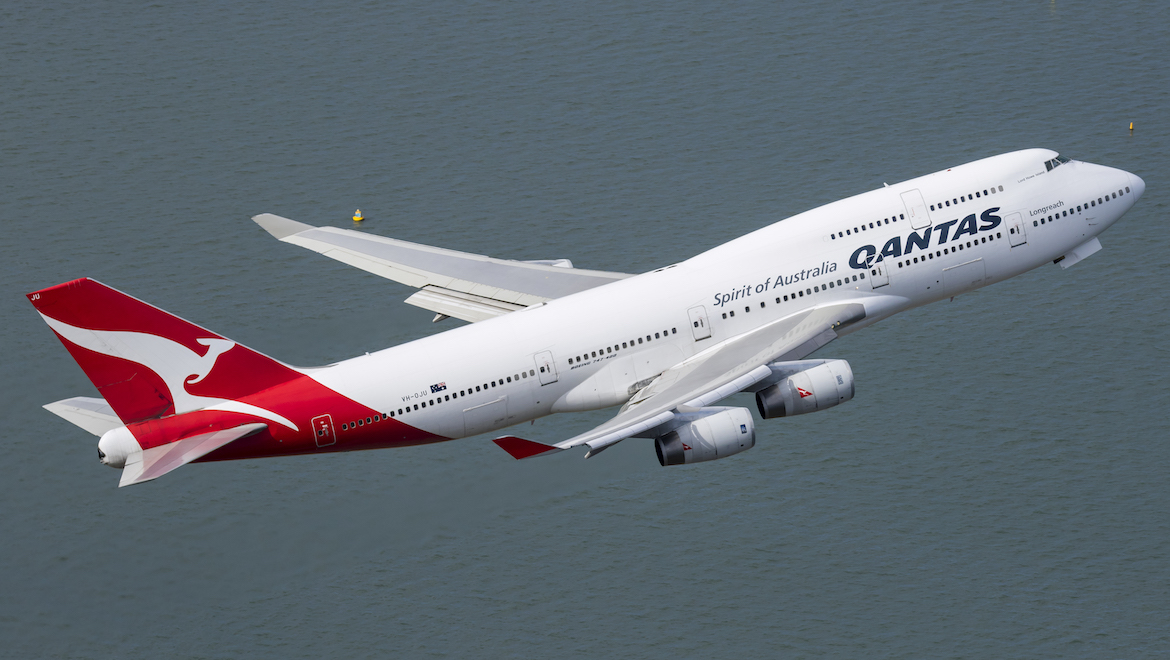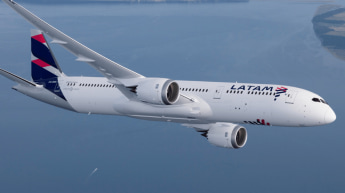
Qantas has retrained its pilots for some stall recovery techniques following a “stick shaker” incident on a Boeing 747-400 prior to landing in Hong Kong, the Australian Transport Safety Bureau (ATSB) says.
The incident occurred on April 7 2017, when VH-OJU was operating the QF29 from Melbourne to Hong Kong with 17 cabin crew and 347 passengers on board.
The ATSB final report published on Wednesday said that the aircraft’s aerodynamic stall warning stick shaker activated as the aircraft entered a holding pattern above a waypoint BETTY.
This led to multiple oscillations of pitch angle and vertical acceleration. During the event, passengers and cabin crewmembers struck the cabin ceiling and furnishings.
The ATSB investigation found that the flight crew, comprising the Captain as pilot flying and First Officer as pilot monitoring as well as a Second Officer, had anticipated being asked to hold between 15,000ft and 16,000ft (FL 150 to FL 160) and had used the flight management computer (FMC) to plan for this to occur.
As such, the Captain asked the First Officer to input 225kt above FL 150 as the target hold speed.
However, as the aircraft approached waypoint BETTY at FL 230, air traffic control instructed the flight crew to descend to FL 220 and hold at that attitude.
An altitude of 22,000ft was then entered in the autopilot altitude selection window.
“However, the flight crew did not adjust the target hold speed in alignment with the higher-than-expected hold level,” the ATSB final report said.
“The flight crew later reported that they were not aware of a higher speed requirement for holding above FL 200.”

The ATSB final report said the aircraft’s speed reduced below both the target speed of 225kt and the minimum manoeuvring speed, which was indicated on the pilot’s flight display (PFD), as it was descending towards BETTY.
This was not noticed by the Captain or First Officer as the Captain was reviewing the Hong Kong approach documentation and the First Officer was looking out to the right of the aircraft in an attempt to identify aircraft traffic in the vicinity of the holding pattern.
Meanwhile, the Second Officer said he had observed the speed reducing close to but not below the 225kt selected.
When the 747-400 began a right turn to enter the holding pattern, it descended through FL 222 and reached a bank angle of a maximum of 32 degrees.
Three seconds after the aircraft began a right turn to enter the holding pattern, the aircraft began experiencing “pre-aerodynamic stall buffeting” as its bank angle increased to a maximum of 32 degrees and speed reduced to 220kt.
In response to the buffeting, the autopilot was disconnected and the Captain pushed forward on the control column to reduce the aircraft’s pitch angle bank angle.
“Due to a desire to remain within the protected airspace of the holding pattern, the captain did not roll to wings level as recommended by the operator’s approach to stall recovery procedure,” the ATSB final report said.
“The captain also did not disconnect the autothrottle as required by the procedure, however, he manually advanced the thrust levers.”
“The first officer observed the captain’s actions and was satisfied that the appropriate actions had been undertaken. He did not identify, and therefore did not call out, that the stall recovery procedure had not been completed.”
The buffeting then stopped and the aircraft continued descending.
However, the aircraft’s stick shaker warning activated twice as the Captain sought to increase the pitch angle to prevent further descent.
During the oscillations in altitude, five cabin crew members struck the cabin ceiling, with three suffering injuries.
A passenger that was in a restroom suffered minor injuries when he struck the cabin ceiling. A second passenger, who did not have her seatbelt fastened, was also injured.

The ATSB report said Qantas had provided flight crew with limited training and guidance relating to the need for crew to re-evaluate their holding speed for a change in altitude, specifically above flight level 200.
In response to the incident, the ATSB said Qantas had updated flight crew training lesson plans and commenced retraining of flight crew in more complex stall recovery events.
Further, Qantas had also amended the 747-400, 787 and 737 flight crew training manuals and updated flight crew ground school lesson plans to ensure standardisation of training.
Separately, Qantas fleet safety Captain Debbie Slade noted the ATSB final report showed the three pilots were managing a number of tasks simultaneously when asked to enter a holding pattern over Hong Kong when preparing to land.
“There was a mismatch between the holding speed and altitude entered into the flight management computer, which the crew was alerted to by one of several safeguards on the flight deck,” Captain Slade said in a statement following publication of the ATSB final report on Wednesday.
“In correcting the aircraft’s path, the crew was very conscious they were operating in congested airspace and had limited room to manoeuvre, which added to the sense of turbulence in the cabin.”
“We take these incidents very seriously and use them as an opportunity to reinforce procedures and improve safety.”
Qantas said its pilots went through four recurrent simulator training sessions every year.
ATSB executive director for transport safety Nat Nagy said: “Balancing competing attention or decision demands can interrupt trained flight crew responses leading to procedures not being completed in full, particularly so if flight crews are not receiving comprehensive and regular training in the application of these skills.”
“Comprehensive theory and practical training can ensure that flight crews have a complete understanding of aircraft systems and maintain effective manual handling skills. This training should provide the knowledge to correctly configure the aircraft’s automatic flight systems and manual handling skills to respond adequately to in-flight upsets.”
The full report can be read on the ATSB website.
















joe jarvis
says:I always find reading about these things that can happen in any sections of flight very interesting it always reinforces the need for the most well trained pilots we can have at quantas well done.
David Palmer
says:“The flight crew later reported that they were not aware of a higher speed requirement for holding above FL 200.”
Really?… throughout their entire flying careers they didn’t realise that TAS must increase with altitude to maintain flight?
And the FO looking out the window attempting to identify traffic? Seriously?
This report is just a ‘slap on the wrist’ for the crew with the finger pointed at ‘training’ as the scapegoat.
Ian Appleby
says:There’s a saying that to feel and sense the way the aircraft is flying, need to go back to basics of flying, to much automation in flying now, aerobatic pilots know this ,if they are out of balance, it feels terrible.
Passenger
says:I was on that flight and the pilot made an announcement afterwards that another plane had came too close to our flight and caused turbulance!!
Peter Summerfield
says:To much automation.let the pilots fly the plane.